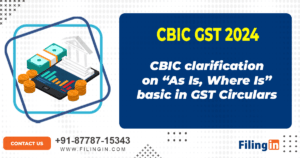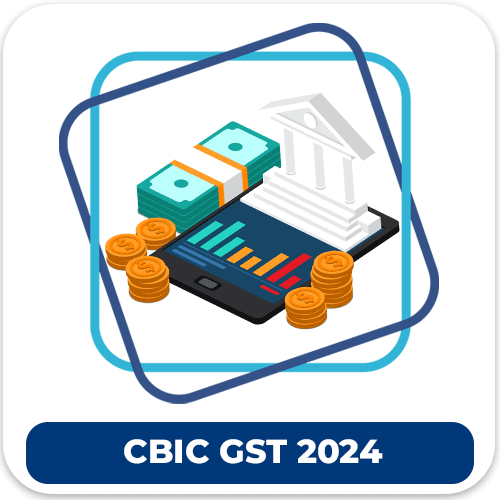CBIC Issues Clarification on “As Is / As Is, Where Is Basis” in GST Circulars
The Central Board of Indirect Taxes and Customs (CBIC) recently issued a crucial clarification regarding the terminology “as is” and “as is, where is basis” as it applies to Goods and Services Tax (GST). This clarification, issued via Circular No. 236/30/2024-GST on October 11, 2024, was made following the recommendations of the GST Council‘s 54th meeting held in September 2024. The circular seeks to resolve ambiguities surrounding these terms, particularly in how they relate to GST compliance for businesses engaging in certain types of transactions, such as the sale of used goods or repossessed assets. Let’s break down the main points of this clarification and explore what it means for taxpayers.

What Is “As Is / As Is, Where Is Basis”?
At its core, the term “as is” refers to the sale of goods in their current state, without any warranties or promises of improvement. Similarly, “as is, where is” emphasizes that the goods or property will not be moved from their location before the sale, meaning the buyer must accept them in their existing condition and place.
But how does this relate to GST? Well, it’s essential in determining how businesses should treat certain types of transactions for tax purposes. For instance, when businesses sell repossessed goods or assets, they may sell them on an “as is, where is” basis, which has important implications under GST law.
Key Clarifications in Circular No. 236/30/2024-GST
1. Resolving Past Ambiguities
The GST Council had identified that previous circulars left businesses uncertain about how “as is” transactions should be treated for GST compliance. This new circular clears up confusion, explaining that businesses can consider payments made under the “as is” clause as fulfilling their GST obligations in cases where there have been differing tax rates or interpretations.
2. Regularization of Past Payments
In some cases, businesses have paid different GST rates for the same goods. For instance, some may have paid 5%, while others may have paid 12%. This circular makes it clear that those who paid a lower GST rate will be treated as having fully discharged their tax liability for the period covered by the circular, and no additional payment will be required.
3. No Refund for Higher Payments
However, for businesses that paid a higher rate, no refunds will be issued. For instance, if you paid 12% GST on a transaction while others paid 5%, you will not be entitled to a refund of the difference. This regularization is designed to streamline tax procedures without overcomplicating them with retroactive adjustments.
Detailed Breakdown of GST Application
The new circular includes several illustrations to help clarify how these rules will apply in practice:
Illustration 1: 5% vs. 12% GST Rate on Goods
In some instances, there were competing rates of 5% and 12% for the same supply. If the GST Council decides to lower the rate to 5% for future transactions and apply it retroactively, those who paid 5% previously will not be required to pay the difference. For those who paid 12%, no refunds will be issued.
Illustration 2: Exemption Entry Confusion
In cases where certain goods were believed to be exempt from GST but were later clarified to have a 5% GST rate, those who didn’t pay GST due to genuine confusion will be considered to have fully discharged their liabilities, meaning they won’t owe back taxes. Again, those who paid 5% won’t receive refunds.
Illustration 3: Competing Rates with No Payment
If some taxpayers didn’t pay GST at all, believing the supply was exempt or misunderstood the applicable rate, they won’t benefit from the regularization. In cases where the rate is clarified at 12%, those who failed to pay will need to settle their tax dues at the corrected rate.
Implications for Businesses
1. Simplified Compliance
This clarification offers businesses the opportunity to simplify their GST compliance when dealing with goods sold under the “as is, where is” basis. Rather than requiring businesses to revisit past transactions to correct minor errors, the CBIC has provided a clear path forward, allowing certain lower-rate payments to stand as full tax discharge.
2. Protection Against Refund Claims
The circular also protects the government from having to issue large refunds in cases where taxpayers may have overpaid GST due to confusion over applicable rates. This prevents significant budgetary impacts on government revenue while keeping the system fair for all taxpayers.
3. Consistency Across the Board
By regularizing past payments on an “as is, where is” basis, the CBIC ensures that businesses and tax authorities follow consistent practices when dealing with GST on ambiguous transactions. This reduces the likelihood of disputes and audits related to past payments.
The Role of the GST Council
The GST Council plays a central role in the issuance of such clarifications. Their 54th meeting, which took place in September 2024, was where this particular clarification was recommended. The Council consistently reviews tax policies, helping to adapt GST regulations to the needs of businesses while ensuring compliance with national tax laws.
Conclusion
The CBIC’s clarification on the “as is” and “as is, where is” basis for GST is a positive step toward reducing ambiguity and fostering a clearer understanding of GST law. It benefits businesses by simplifying compliance, particularly for those dealing with used goods, repossessed assets, and similar transactions. By regularizing past payments and preventing refund claims for overpaid GST, this move helps maintain stability in the tax system while ensuring fairness across industries. As businesses continue to navigate GST, this clarification will undoubtedly provide much-needed guidance and confidence.
FAQs
1. What does “as is, where is” mean in GST terms?
In GST, “as is, where is” means that goods are sold in their current condition, with the tax liability being treated as fully discharged even if paid at a lower rate, without the possibility of a refund for higher payments.
2. Will businesses need to adjust their past tax payments?
No, under the new circular, businesses that paid GST at a lower rate will not need to adjust their past tax payments, as these are treated as fully discharged.
3. What happens if I paid a higher rate of GST?
Unfortunately, no refunds will be issued for those who paid a higher rate. The government is focused on preventing overcomplications with retroactive adjustments.
4. Does this circular apply to all types of goods?
The circular is particularly relevant to businesses involved in the sale of used goods, repossessed assets, and similar transactions where ambiguities in GST rates existed.
5. How does this affect future transactions?
Going forward, businesses can use this clarification to ensure they are paying the correct GST rate on transactions involving goods sold on an “as is, where is” basis, avoiding future confusion.

